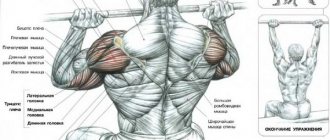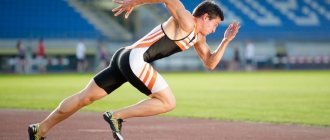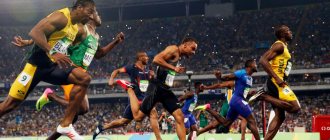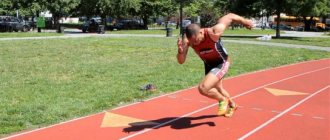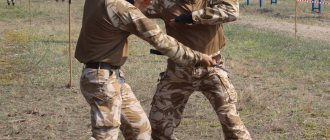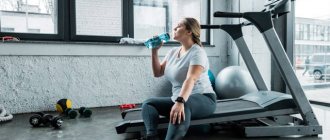Standards for running 1000 meters
Men's
| Adults | Youth | |||||||
| MSMK | MS | KMS | I | II | III | I | II | III |
| — | 2:22.24 | 2:28.24 | 2:37.24 | 2:49.24 | 3:03.24 | 3:18.24 | 3:35.24 | 3:54.24 |
Women's
| Adults | Youth | |||||||
| MSMK | MS | KMS | I | II | III | I | II | III |
| — | 2:45.24 | 2:56.24 | 3:07.24 | 3:21.24 | 3:37.24 | 3:54.24 | 4:14.24 | 4:45.24 |
Youth
| Boys | Girls | ||||
| Grade | |||||
| 5 | 4 | 3 | 5 | 4 | 3 |
| 3.30 | 3.40 | 3.55 | 4.40 | 5.00 | 5.40 |
School students (high school)
| Boys | Girls | ||||
| Grade | |||||
| 5 | 4 | 3 | 5 | 4 | 3 |
| 3.30 | 3.50 | 4.20 | 4.40 | 5.00 | 5.40 |
Occupational safety briefing
Injury prevention is ensured by:
- careful fitting of uniforms, sportswear and shoes;
- checking the serviceability and safety of sports facilities, exercise venues, inventory and equipment;
- maintaining high discipline during classes and competitions;
- advance preparation and use of safety equipment and assistance in performing exercises (techniques) associated with risk and danger;
- taking into account the health and physical fitness of personnel who have suffered from illness;
- constant monitoring of external signs of personnel fatigue;
- explanatory work among personnel about measures to prevent injuries;
- compliance with measures to exclude the possibility of frostbite and other fainting conditions.
World records
The 1000 m race is not regulated at the Olympic Games, World and European Championships, therefore, not many records have been recorded. Experts say that if such a race were included in world competitions, it is highly likely that the record holder would be David Rudish, who showed the best result at a distance of 800 meters - 1:40.91.
Men
| Record set | Record holder | A country | Place | date |
| 2:11.96 | Noah Ngeni | Kenya | Rieti | 05 September 1999 |
Women
| Record set | Record holder | A country | Place | date |
| 2:28.98 | Svetlana Masterkova | Russia | Brussels | August 23, 1996 |
Athletes who set a world record must defend it, according to IAAF rules:
- Each athlete, after setting a world record, must undergo doping control by the IAAF committee.
- The race must take place with the participation of two athletes.
- The markings on the race course must comply with IAAF criteria.
- The race must consist of same-sex athletes.
- IAAF rules prohibit saving energy by using the pacemaker by hiding behind him in order to reduce wind resistance.
Stages of passing standard requirements
The 1 km running standard for schoolchildren is regulated in accordance with the age abilities of the students. Each group of children has its own passing level; the higher it is, the more serious the requirements.
1st stage – 6-8 years. At this age, time is not taken into account when testing physical fitness. 2nd stage – 9-10 years. Level 3 – 11-12 years old. 4th stage – 13-15 years. 5th stage – 16-17 years old. For boys and girls, different standards for running 1 km are determined. This is explained by the fact that the physical development of boys and young men develops rapidly every year (especially in adolescence). Great hope is placed on the representatives of the stronger sex, as they are potential defenders of the Motherland in the future.
Running technique
At a 1000-meter distance, each runner must optimally implement all the necessary movements to overcome it. It is necessary to strive to achieve the speed at which the athlete plans to run in competitions. To control movements, it is necessary to master not only each element, but also the structure as a whole, improving the entire technique.
With the help of exercises, the desired effect of the movements performed is achieved. When fatigue sets in, you will need experience changing your technique. Running technique is subject to analysis using the stages: start and starting acceleration, running along the distance and finishing.
Start and starting acceleration
The first thing any competition begins with is the correct position at the start. In the 1000 meter race, athletes start the race from a high start. Athletes line up along the starting line. One leg is a push leg, it is placed in front of the line. The second leg is behind, the distance from the first leg is equal to the length of the foot and starts from the push heel. The athlete rests his entire body on his front leg. Both legs are slightly bent.
The opposite arm to the leg in front is bent, while the other arm is pulled back. After the command “March”, without straightening up, the runner starts and rushes forward. To ensure acceleration at the start, you must first gain speed and then gradually reduce it.
Distance running
The step length should be from 190 to 220 cm, with a step frequency of 3.5-4.5 per second. To move your leg forward, you need a body tilt of 4 to 5 degrees, with a permissible deviation of 2 to 3 degrees. This is the optimal indicator. The arms move freely, bent at an angle of 90 degrees, matching the movement of the legs. The body is in balance thanks to the movement of the arms, which helps to run by speeding up or slowing down. The feet are lowered onto the track, on both sides of the line, from the foot of the front foot.
During repulsion, the legs straighten. The angle is from 50 to 55 degrees, the shin is parallel to the pushing leg. The free leg swings, ending with the hip braking during push-off. This gives the runner a bit of a break. Relaxation of the leg occurs after the push, it reaches behind the thigh after bending. The second leg is thrown forward, in the shin area. When pushing off, the hip joint makes a turn, due to which the hips are brought together.
The leg is bent at the knee, softening the landing when placing the foot on the track. At this time, the athlete is helped to rest by a position in which the shin of the leg located behind is pressed against the thigh, preparing to throw the leg forward and then up. This ensures repulsion along with muscle contraction.
This technique requires differentiation and consistency. The push emphasizes the pushing of the big toe. The torso, making a turn, is directed towards the inside of the treadmill, the foot of the right leg turns with the heel outward. The right hand moves actively.
The effect of the technique is as follows: the torso is slightly tilted, the shoulders are straightened, the pelvis moves forward, the head is in a straight position, while the chin should be lowered. The face and neck do not strain, the arms move easily and freely.
Finishing
During the finishing, the athlete's skill is revealed, such as the ability to overcome fatigue and use all his strength to make a breakthrough at the finish line. On the approach from 200 to 400 meters, the torso leans forward, the stride increases in length and speeds up. The run at the finish turns into a sprint. At the initial segment, before the finish line, all efforts should be distributed evenly.
After crossing the finish line, do not stop, but gradually take a step, breathe, exhaling deeply.
How often are standards checked in the army?
The commander is obliged to regularly conduct sports testing of his personnel and assess the level of physical development of his subordinates. Such events are held quarterly among all those who do not have medical contraindications to increased workload. When entering military service upon conscription, a conscript will have to pass his first standard - 1 km run. In the Army, a new soldier is given no more than 2 weeks to prepare before his athletic skills are assessed. Also, the standards are submitted before signing the next contract and upon appointment to a higher position. The time in which a military man must complete the distance is determined by his age group. So, men under 30 years old must run 1 km in 3 minutes 55 seconds, and those over 30 years old are given 4 minutes.
The salary of army men depends on how successfully they pass the test. After being assigned a sports rank in running, for example, a serviceman’s salary increases. Some annual bonuses are given only to those who have proven their physical fitness.
Training program
To learn how to run 1000 meters, you need to develop general endurance, therefore, the first thing you need to start with is to increase your running volume. The minimum and required amount is 3 times a week. At the same time, overcome cross-countries slowly, at walking speed. The main attention should be paid to volumes. While running, do not stop.
Lack of strength while running indicates that the chosen distance is too long or the running speed is unacceptable at this stage. This technique promotes optimal loads and the development of skills to overcome fatigue. The body is trained as efficiently as possible.
The next phase of the training is timed running and fartlek. The rest time when running in segments should be two minutes and spent in motion. At the same time, you should restore your breathing and walk slowly. All segments are run at the same speed, and then at an accelerated speed, achieving the result planned for the competition.
Fartleks run for several kilometers, the first 500 meters - slowly, and then they accelerate for 100 m, switch to a walk and walk 50 meters. At this time, the pulse should recover, after which the pace will pick up again. This is how the whole training goes. The speed of accelerations and their duration can be increased when the body is sufficiently trained. The frequency of fartlek is once a week.
Do schoolchildren need such standards?
There are many opinions from the students themselves and their parents, and most of them contradict each other. Some people believe that the stated requirements make it possible to identify talented children in sports and are a matter of motivating the younger generation to develop and improve their skills. To achieve a good result and get a decent grade, physical training is necessary, during which muscles develop and strengthen. Regular exercise strengthens the immune system, improves health, and maintains emotional well-being. This practice is important for children, who are known to be active and have high energy levels. Psychologists emphasize that teenagers involved in sports, as a rule, do not exhibit pronounced deviant behavior, unlike their non-sports peers. There is also an opinion that the existence of such standards infringes on the rights of non-athletic schoolchildren who do not have a predisposition to physical activity. The 1 km running standards are also inhumane and do not demonstrate the actual level of physical development of the child. However, any school subject can be accused of such discrimination. It should be noted that, despite the diversity of opinions, passing test results in physical education is part of the compulsory school curriculum.
Recommendations
For the first 50 meters, the runner uses all the possibilities and accelerates at the highest speed. This way, the athlete will take more advantageous positions and avoid being blocked to the left edge. After this the pace slows down. Having picked up the pace, you need to maintain it and monitor the expenditure of energy, and maintain speed.
200 meters before the end of the distance the speed increases. 100 meters before the end of the distance the transition is calculated. In this area you need to give it your all.
Regular training and technical preparation will help you run successfully. Not only the physical fitness of the athlete is of great importance, but also the quality of his preparation, which he has achieved, observing all the requirements for middle-distance running. Otherwise, his success will be far from ideal.
Anyone can reach the “Master of Sports”!
Marathons, half marathons, races... Every year the calendar of athletics competitions becomes more and more eventful. And the ranks of fans of the “queen of sports” are growing exponentially. Nowadays, the average runner is a person aged 35 years and older.
But even if you start studying at an adult age, you can, it turns out, qualify for some ranks and titles.
General warm-up
A general warm-up is needed to prepare the entire body for training. In its process, as a result of an increase in body temperature and warming up of muscles, metabolism is activated, the state of the cardiovascular and respiratory systems changes for the better, and muscle performance increases.
Failure to do such a warm-up can lead to illness and injury.
The duration of the warm-up largely depends on the athlete’s level of preparedness, air temperature, training clothing, etc.
Warm-up before training includes the following types of physical activity:
- jumping rope;
- various exercises for the muscles of the arms, torso, legs;
- exercises to increase the flexibility of the arms, legs, and spine by rotating all joints (from the interphalangeal joints of the hands to the ankles).
Regardless of what kind of warm-up an athlete follows, there is always only one result - all muscles must be warmed up.

